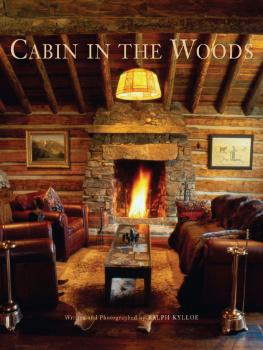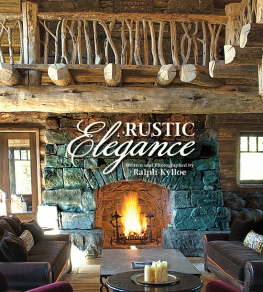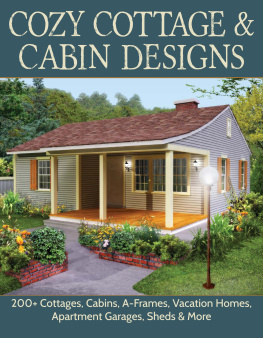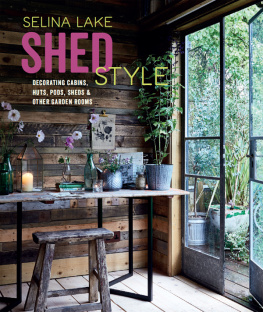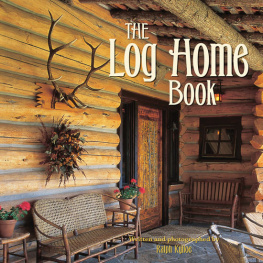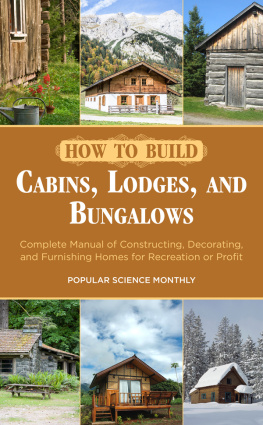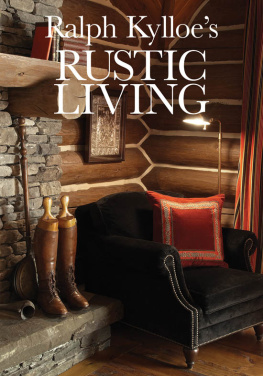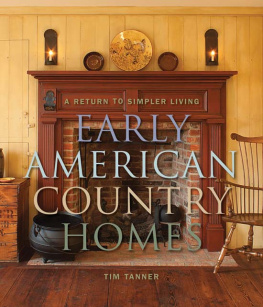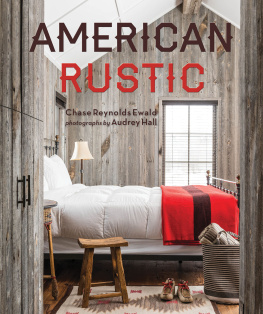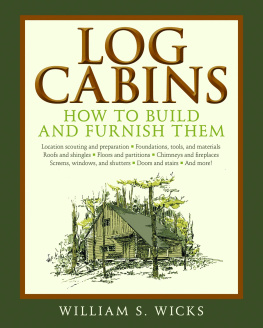All rights reserved. No part of this book may be reproduced by any means whatsoever without written permission from the publisher, except brief portions quoted for purpose of review.
1. Vacation homesUnited States. 2. Log cabinsUnited States. I. Title.
Introduction
Ive wanted to do a book on waterfront homes for a long time, and this book is indeed a collection of rustic homes that are situated on lakes, rivers or ponds. However, it is difficult to see this in most of the photographs because trees often obstruct views of the water from the houses.
Although for centuries humans lived near water mostly for subsistence purposes, in our day water is piped everywhere and even desert communities thrive, thanks to this precious resource.
Strangely, but conscious of obvious realities, many primitive cultures have purposely avoided waterfront living. Interviews with indigenous peoples in South America and Africa have indicated that although waterfront living has its advantages in terms of transportation, food supplies, fresh water for bathing and cooking, as well as for reasons purely aesthetic, many tribes choose to live distinctly away from the waterfront. Insects that live by the trillions near water can literally drive someone crazy, to say nothing of the dangers of deadly diseases transferred by these nasty creatures. Crocodiles, alligators and hippopotamuses have also been known to make the lives of people who ventured into their territory quite miserable. I am reminded of a story of a Peace Corps worker who tried in vain to teach the people of a small African village to swim. Seeing that her students were quite reluctant to enter a local river, the teacher dove in to demonstrate the joys of immersing oneself in cool water. Seeing a village elder, the teacher asked why no one would enter the water. The chief calmly replied that the crocodiles usually eat us when we swim. The teacher refocused her attention and concentrated on teaching mathematics and writing.
In spite of these dangers, why, then, do people choose to build homes practically on the water? Because we love it! And if we cant live near the water, we often vacation by it or swim in pools or purchase inflatable pools that hold only a few gallons of water, and we soak our tired toes in it after a hard day of work. When nothing else is available well strip down to our skivvies and make fools of ourselves by squirting the water hose at our kids, spouses and friendsand what fun it is! Besides being fun, water cools us down when were too hot. It completely takes our minds off any tedium and troubles we may be having.
On a more serious side, although some people will take offense at this, living creatures came from water. We are, in reality, more than 50 percent water ourselves. Alien creatures in an episode of Star Trek: The Next Generation, referred to humans as bags of water. And that we are! Its inside of us and we are a part of it. Water is strange stuff. It offers mystery and folly. It is quite unexplainable in its physical state. It magically loses its form and descends quickly downward, responding to the force and call of gravity. Yet, when it freezes, it responds perfectly to the laws of physics that are the same throughout the entire cosmos. And it can disappear in front of our very noses. Turning into formless gas, it fires the imagination as we watch billowing clouds rumble across the skies. It is the ultimate Rorschach test.
Weve been known to ponder the great questions of life on the shores of the great oceans. We sail upon the waters and we swim in it. We consume the very products of the oceans and marvel at the variety and beauty of the life within it. We thrill at its calmness and we marvel at its violence and beauty. The sounds and rhythms of the waters quiet us and remind us of our time spent in the womb of our mothers. We live on a blue planet. We could not and would not exist without water.
At the same time there is tremendous mystery in the water. We thrill and cower as we consider the mysterious entities that dwell in the deep. Its beauties are vast and its dangers are ever present. It both excites us and frightens us as we contemplate our relationship with water. It is part of us and we belong to it. It offers an unmistakable, unspoken magnetism.
So, with good reason, we create both grand and simple homes on the shores of the water. And if we have not a waterfront home then we either camp near it or live as close as we can to it or bring a man-made fountain into our surroundings to imitate it. Or we spend our vacations splashing in the waves, traveling upon it or diving below it.
The homes we create that allow us to enjoy the water are varied and many. We create forts that guard us and floating platforms that house us. Sometimes we even foolishly build our homes directly in the paths of potential water disasters and humbly pray that they pass us by. It is a chance, apparently, that we are willing to take. We build homes on grand lakes and on flowing rivers. The closer to the water the better.
Apart from all the romance and worry, we simply love the water. We cherish the memories of carefree youth at summer camp and we revel in the joys of family outings along the shores of the oceans, lakes, ponds, rivers and streams.
Ive spent the past thirty years in the rustic design business. Log cabins and all the natural surroundings and furnishings that come with them thrill me. Rustic homes have come a long way in the past few decades. There seems to be a much greater concern for green considerations than there was just a few years ago. And along with that, many designers of traditionally built homes are incorporating rustic elements into the their structures. Builders are adding a rustic porch or a rustic den or living room. Designers are adding a piece or two of very high-end rustic furnishings to traditional residential settings.
With these thoughts in mind, out of the hundreds of structures Ive seen, I chose a dozen or so homes to include in this book. They represent a broad spectrum of residences, from tiny riverfront cabins to very large family compounds. And to demonstrate innovative rustic styling, Ive also included a few modern homes that offer an assortment of rustic architectural elements and high-end rustic furnishings.
As always, there are many people to thank for their help with this book, and I am certain I have inadvertently omitted some who should be mentioned here.
I wish to offer a profound thank-you to the following individuals, including the Steve Byers family, the Carter Bales family, John and Nancy Blangardio, Blake Vincent and family, Paul and Melina Bodor, Randy Holden, Barney and Susan Bellinger, Joe and Peter Pepe, Brian Kelly, Chris Wager, Peter Winter, Eric Gulbrandsen, Lori Toledo, Dan Ryterband and family, Marvin ODell, Adam ODell, Sally Thurston and family, Todd Klymkom, Jamie Simonds, Jerry Ward and Family, Barbara and Doug Grose, Harry Howard, Nicole Bates, Architect Candace Miller, Norman Van Deist, Dennis Derham, Julia Miller, Keith Anderson, Alyssa Ruffie, Katie Lineberger, Robert and Liz Esperti, Chad Oster, Queen Jackie Spitler, and many others.
I am also deeply indebted to my publisher, Gibbs Smith of Layton, Utah, for his continuing vision and efforts to document and publicize the entire rustic movement. Also I must mention Christopher Robbins, CEO, and my editor, Madge Baird, whose editing and guidance allow me to do what I do. Madge, I personally thank you for your many years of friendship and for not firing me on many occasions when you should have. How youve tolerated me and my occasionally bizarre behavior all these years Ill never know. Im a better person because of you. Thanks also to architect Larry Pearson of Bozeman, Montana, who has consistently pushed the envelope by designing many of the greatest rustic structures of this century.


